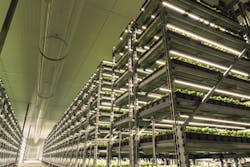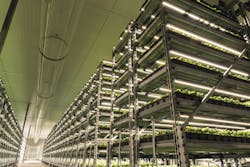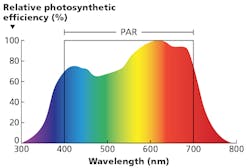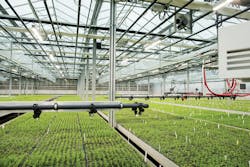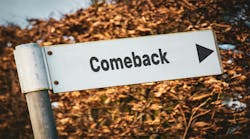The true efficacy of LED fixtures for horticultural lighting depends on many factors, explains JOSH GEROVAC, and lighting manufacturers and growers need to take a broad view to ensure optimal yields and energy efficiency.
There are multiple considerations that a business faces when evaluating light sources to use for horticultural lighting, including but not limited to: light intensity, spectrum, uniformity of light distribution, energy efficiency, and fixture lifespan. Horticultural lighting systems convert electrical energy into light that plants use to drive photosynthesis for growth and development, and LED-based sources can offer a spectrum tuned for the application. Still, ascertaining the efficiency or efficacy of such solid-state lighting (SSL) systems is a challenge. There are several factors that impact the overall efficiency of a lighting system, relative to the specific application at hand. This article will discuss how the design of a lighting fixture influences energy efficiency and how in turn this reality can influence the overall profitability of a controlled-environment plant growth facility.
Interested in articles & announcements on horticultural lighting?
Indeed, the efficacy with which a horticultural light fixture converts electrical energy into usable light for plant growth is critical to the success of any controlled environment plant growth facility - often called CEA (controlled environment agriculture). Fig. 1 shows a vertical farm that is one example of CEA. Realize that the efficacy consideration is necessarily far different for lighting tuned for plants compared to lighting tuned for humans.
Metrics for horticulture
We will start by defining the proper metrics used for horticultural lighting applications to add context for the rest of the article. Plants primarily use wavelengths of light within the visible range of 400-700 nm to drive photosynthesis (Fig. 2), which is why this range is also called photosynthetically active radiation (PAR). Photosynthetic photon flux (PPF) measures the total amount of PAR that is produced by a lighting system each second. This measurement is taken using a specialized instrument called an integrating sphere that captures and measures essentially all photons emitted by a lighting system. The unit used to express PPF is micromoles per second (μmol/s).
Photosynthetic photon flux density (PPFD) measures the amount of PAR that arrives at the plant canopy. PPFD is a spot measurement of a specific location on your plant canopy, and it is measured in micromoles per square meter per second (μmol/m2/s).
Last, we will discuss photon efficacy, which refers to how efficient a horticultural lighting system is at converting electrical energy into photons of PAR. If the PPF of the light is known along with the input wattage, you can easily calculate photon efficacy for a horticultural lighting system. Given the unit for PPF is μmol/s, and the unit to measure watts is joules per second (J/s), the seconds in the numerator and denominator cancel out, and the resulting unit becomes μmol/J, which is the unit of measure used to represent efficacy. The higher this number is, the more efficient a lighting system is at converting electrical energy into photons of PAR.
Common approaches to horticultural lighting
Now that we have covered the proper metrics to characterize horticultural systems, we can dive into the nuances of fixture design and what makes a horticultural lighting system energy efficient. The most commonly used horticultural lighting systems worldwide are based on high-intensity discharge (HID) lighting and mainly high-pressure sodium (HPS) lamps. HPS fixtures were not designed specifically to grow plants. They were designed to light roadways and parking garages. Ready availability and high output levels, however, led to deployment in horticulture and subsequently their popularity in the application can be attributed to the fact that they deliver very high light intensities and most of the light emitted is in the 565-700-nm range - effective wavebands that can drive photosynthesis.
One drawback to using HPS fixtures for horticultural lighting is the large amount of radiant heat that is produced. The surface temperature of HPS bulbs can reach temperatures above 800°F, which necessitates adequate distances between the plant canopy and the fixture to avoid damage to plant tissues. The inverse square law comes into play as you increase the mounting height of a fixture, which can reduce the coefficient of utilization (CU), a term used by lighting professionals to describe how effective a luminaire is at delivering light to a target plane. The energy efficacy of HPS fixtures has increased over the years and with the advent of double-ended HPS fixtures that are now capable of achieving photon efficacies of 1.7 μmol/J.
Moving toward LEDs
Let's consider the chronology of the application leading to LED use in horticultural lighting. In 2014 the most efficient LED-based horticultural lighting systems were as efficient as double-ended HPS fixtures. The long lifespan (L70 ≥50,000 hours) compared to that of an HPS bulb intrigued several growers to switch to LEDs. However, the relatively high cost of LED-based horticultural lighting systems compared to HPS fixtures limited the transition to SSL despite comparable efficacy.
LED chip manufacturers have improved the efficacy of components available to horticultural lighting manufacturers over the last several years, which has enabled them to significantly improve photon efficacies that now surpass HPS fixtures, and they continue to improve every year. Indeed, LED-based horticultural lighting systems are now capable of achieving photon efficacies 45% greater than double-ended HPS fixtures. While the improved efficacy of individual components has improved the efficiency of LED-based horticultural lighting, it is also just one variable responsible for the improvement over HPS technology.
LED system thermals
There is a common misconception surrounding LED lighting when it comes to heat produced by the fixture. Many growers believe that LEDs produce less heat than HPS fixtures, which is only true if the LED fixture is driven at a lower wattage. If you have a 600W LED fixture and a 600W double-ended HPS, they will produce heat in the same general range from a magnitude perspective.
The major difference between LED and HPS systems is how much PAR energy is produced from those 600W (goes back to efficacy), and how the heat is radiated from the fixture. Most heat from HPS lamps is radiated down towards the crop canopy, whereas LEDs produce most of their heat at the connection site of the component where it is assembled to a printed circuit board (PCB). And the heat is typically conducted to the PCB and maybe a heat sink, and removed via upward convection.
So the proximity at which a fixture can be placed near plants without damaging tissue from radiant heat is one of the major benefits of LEDs as a source for horticultural lighting systems. However, if this heat is not removed effectively from the PCB with an appropriate thermal management system, the longevity of the LED components will decrease significantly.
There are two ways to cool lighting systems in commercial horticultural environments that will impact the photon efficacy of the fixture. Passively cooled fixtures utilize heat sinks to dissipate heat from the circuit board, while actively cooled fixtures rely on fans or water to dissipate heat. Fans that are used to cool fixtures consume energy and will decrease the overall photon efficacy of a fixture. Additionally, if a fan fails during the operation of the fixture, the LEDs on the PCB are likely to overheat and burn out. Even if they don't fail catastrophically, reduced power output will dramatically reduce the usable life of the LED fixture. This is a very important feature that growers need to consider when comparing horticultural lighting systems.
Spectrum and efficacy
Another important feature that will influence the photon efficacy of a horticultural lighting system is the spectrum of light emitted. The most efficient wavelengths that are used for horticultural lighting systems are red (660 nm) and blue (450 nm). Traditional LED-based horticultural lighting technology uses mainly red LEDs with smaller proportions of blue to achieve the highest photon efficacy possible.
While red LEDs have the highest photon efficacy, plants did not evolve in nature under narrowband wavelengths. So red LEDs alone don't produce the most efficient spectra with regard to optimizing plant growth and development. This is especially true in situations where lighting systems are used for sole-source lighting as in vertical farms, as compared to supplemental greenhouse lighting (Fig. 3).
Several horticultural lighting manufacturers market their products' "special spectrum" based on the absorption peaks of chlorophyll a and b; however, they fail to mention that those chlorophyll pigments are extracted from plant leaves and measured in vitro. The action spectra of light quality on photosynthesis (Fig. 2) was created from research that was conducted in the 1970s by Drs. McCree and Inada, which showed while there is a correlation between photosynthesis rates and the action spectra of chlorophyll a and b, they are not the only wavelengths responsible for photosynthesis. Prior to this research, it was a common misconception that since chlorophyll absorbs light mainly in the red and blue portions of the visible light spectrum (leading to the green color of plant leaves), green light was not used by plants for photosynthesis.
The work conducted by Drs. McCree and Inada was fundamental in understanding the influence of spectral light quality on photosynthesis; however, they developed their action spectra based on single leaf measurements of photosynthesis at low light intensities. Over the past 30 years, several studies conducted on whole plant photosynthesis with higher light intensities indicate that spectral light quality has a much smaller effect on growth rate than light intensity.
Spectral light quality does strongly influence plant developmental responses, such as: seed germination, stem elongation, and flowering; along with secondary metabolites and flavonoids, which influence the taste, look, and smell of plants. Therefore, LED manufacturers need to find a balance between using the most electrically-efficient LEDs and ones that elicit optimal plant growth and development habits that growers desire. The exciting thing about LED technology for horticultural lighting is that researchers finally have the tools available to stand on the shoulders of Drs. McCree and Inada and explore photobiology even further, developing light recipes for optimal growing.
Form factor and beam control
The last topic we will cover has to do with the form factor of a fixture, beam optics, and light intensity. When you are thinking about the overall efficiency of a horticultural lighting system, PPFD and CU need to be considered. But while photon efficacy of the fixture itself is very important for horticultural lighting, if the light being produced in an actual application is not landing on a crop evenly and efficiently, the true energy efficiency of that solution is greatly reduced.
HPS fixtures rely on reflectors to spread light evenly over a crop canopy since there is only a single light source (360° light bulb) per fixture. Another advantage LEDs have over HPS is the ability to have hundreds of light sources spread across a fixture with custom beam optics that can create very uniform light patterns without the use of reflectors. Fig. 4 depicts a typical LED light engine.
When designed appropriately, this flexibility in form allows solutions with very high CUs where the majority of the light generated is landing on the plant canopy and not wasted on aisles or walls in controlled-environment plant growth facilities. After all, any light generated that doesn't reach a crop canopy is wasted energy (and money). This is critical for growers to consider when choosing a horticultural lighting system.
Takeaways
Not all LED lighting systems are created equally, so it is important for growers to get lighting designs from manufacturers that show average PPFD at defined mounting heights and the light distribution pattern for their plant growth facility. The form factor and light distribution of a horticultural lighting system will influence the number of fixtures needed in a facility, which is another factor that will impact the overall energy efficiency of a plant growth facility.
The take-home message is that the energy efficiency of horticultural lighting systems is based on several factors, not just one. Using the correct metrics and understanding the factors that influence the energy efficiency of a horticultural lighting system will influence the overall profitability of a controlled-environment plant growth facility.
For more information on this topic, please see "How to compare grow lights" at http://bit.ly/2lkXDGD.
JOSH GEROVAC is a horticulture scientist at Fluence Bioengineering (https://fluence.science/) and has spent the last decade working in controlled environment agriculture, ranging from growth chambers to commercial greenhouses. He has a Bachelor of Science in Horticulture Production and Marketing, and a Master of Science in Horticulture, both from Purdue University.
